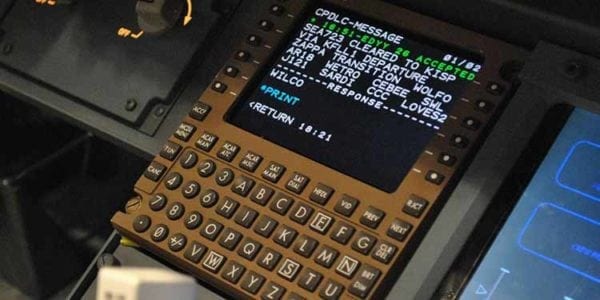
The FAA said it has fixed technical issues with en-route CPDLC. Pictured is a cockpit display with Data Comm, part of the FAA’s CPDLC modernization initiative (Collins Aerospace Photo)
The Federal Aviation Administration (FAA) said this week that it has fixed a lateness in the delivery of en-route use of controller-to-pilot data link communications (en-route CPDLC) messages–a tardiness that occurred twice this year.
Collins Aerospace operates the ARINC Data Comm network, part of the FAA’s CPDLC modernization initiative designed to extend the trans-oceanic digital messaging between pilots and controllers to domestic flights. The FAA has been transitioning Data Comm from its primary use for digital departure clearances in terminal airspace to more advanced functionality for aircraft flying in en-route airspace.
En-route CPDLC is in place at two U.S. Air Route Traffic Control Centers (ARTCC)–Kansas City and Indianapolis, though that number is to increase to all 20 en-route centers by 2021 through upgraded air traffic control (ATC) computers, operational procedures, and controller training.
On Sept. 10, the Air Line Pilots Association (ALPA) posted on its website that “due to technical issues in the air-ground network, CPLDC had been disabled” on Aug. 1, 2019.
“Investigation showed that [sic] a software error in the ARINC network, and ARINC began work on a fix,” ALPA posted at the time. “Airlines served by SITA were re-enabled in mid-August. ARINC has now implemented its air-ground network fix, and after some initial testing, airlines served by ARINC are being re-enabled to restore full service by 9/15/2019. Pilots should follow company guidance for airborne CPDLC use as it is re-enabled.”
The problem “involved a very rare technical condition where messages could be delivered late to the aircraft,” the FAA wrote in an email this week to Avionics International in response to questions. “The FAA routinely conducts extensive and thorough testing associated with the deployment of new capabilities to uncover any potential operational issues such as this one, so that they can be corrected. Two of these types of technical issues associated with late delivery of messages were uncovered this year and both have been fixed in the air-to-ground networks. There has not been a recurrence of these types of issues seen since the last fix was deployed on September 5. As safety is always our top priority, the system used by the controllers already has safety features built in so that if this issue were ever to surface again the controllers are alerted so the appropriate actions can be taken.”
Collins Aerospace said that Future Air Navigation System Departure Clearance (FANS DCL) continued to function during the FAA’s temporary disabling of en-route CPDLC.
“The network issue that caused added latency in message up-links for U.S. en-route CPDLC services was uncovered in the ARINC network on August 8, 2019,” according to a Collins Aerospace email to Avionics International in response to questions. “The proposed return to service date at the time was 30 days, to include fix and testing. During that time affected operators were asked to not participate in en-route CPDLC in the continental U.S., which was only offered (and to this date is limited to) Kansas City and Indianapolis Centers. The FANS DCL departure clearance service continued to work for all operators at the 62 participating airports around the nation.”
“To put the brief outage into perspective: A flight from Nashville to DuPage would fly through en-route CPDLC enabled airspace for a total of 30 minutes at M.80 (Mach .8),” according to Collins Aerospace. “During that time, the flight would receive a total of two CPDLC up-links from ATC., one message indicating that the flight has entered en-route CPDLC enabled airspace, and asking the crew to monitor a voice VHF frequency, and another message terminating the service a few minutes later. Due to the outage, those messages were replaced with VHF voice calls.”
ALPA lauded the FAA for working to fix the technical issues that led to the temporary disabling of en-route CPDLC.
“Data Comm is beneficial for pilots, air traffic controllers, and the flying public,” ALPA wrote in an email this week to Avionics International. “By providing highly accurate information, Data Comm helps pilots to save time, improve efficiency, and most importantly, maintain a high level of safety while flying. We applaud the FAA for working diligently with communications service providers to ensure that the system is working as intended and is safe.”
Pilot use of CPDLC in en route airspace will allow air traffic controllers to send data link clearances and instructions to pilots, including climbs, descents, reroutes, and hand-offs between ATC sectors in the ARTCC environment. CPDLC may also improve flight safety as reroutes are provided in a form that allows for their loading directly into the Flight Management System–an automatic loading that could eliminate typing errors and name confusion.